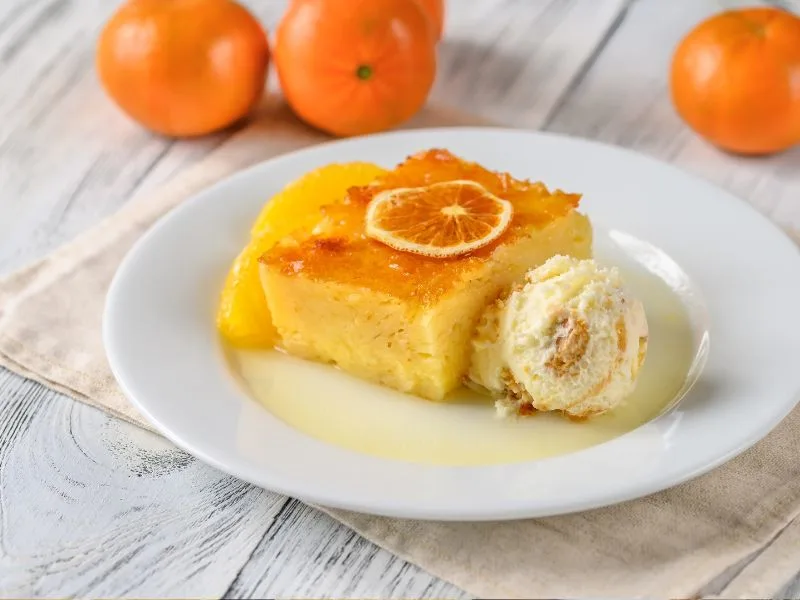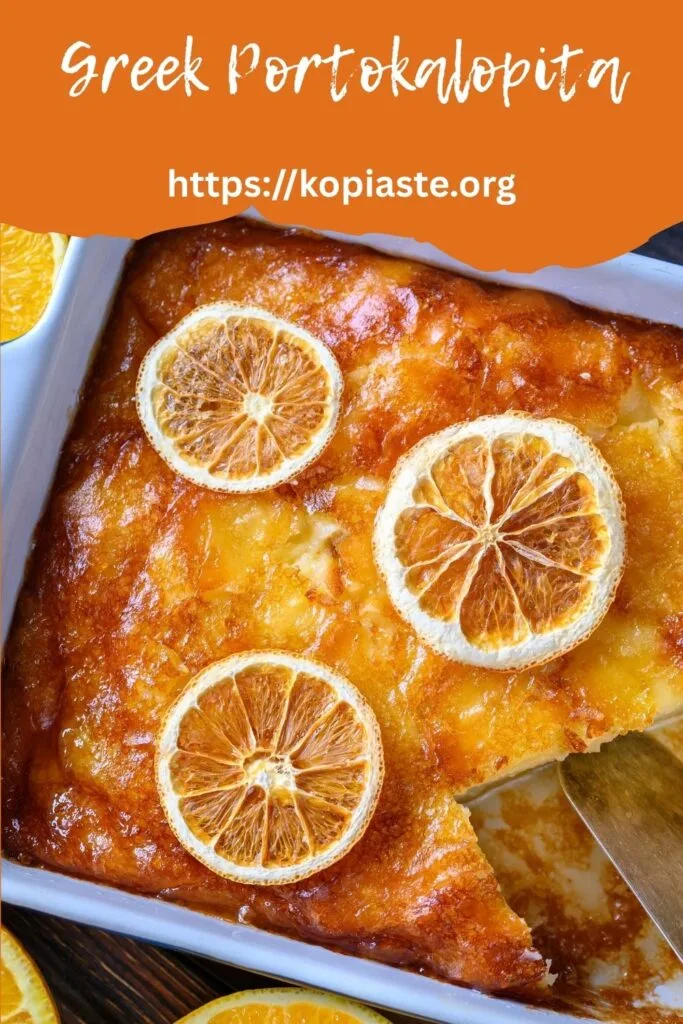This Greek Traditional Portokalopita (pr. por-toh-kah-LHO-pee-ta), is one of those recipes that every Greek family seems to have a version of. (See an older post of mine for a non traditional Portakalopita, which is one of my concoctions)!
Its name comes from portokali, meaning orange, and pita, meaning pie, although it is not really a pie in the Western sense.
It belongs to the beloved family of “syrupy desserts” where a baked sweet is soaked in flavoured syrup.
Unlike most cakes, it is made not with flour alone but with crumbled sheets of phyllo pastry, which give it a unique texture.
Combined with Greek yoghurt, semolina, orange zest and juice, the result is a moist, fragrant dessert that tastes like sunshine on a plate.
August has always been a special month for me. Back in 2007, I pressed “publish” for the very first time and Kopiaste to Greek Hospitality was born.
I never imagined then that eighteen years later I would still be here, sharing recipes, stories and little pieces of my kitchen with all of you.
Anniversaries call for something sweet, and what better way to celebrate than with a traditional portokalopita, one of Greece’s most fragrant and refreshing desserts.
A successful portokalopita depends on a few important steps.
- The first one is preparing the phyllo.
- Instead of layering it as we would in a traditional pie, here the phyllo is dried and crumbled, almost like confetti, and then folded into the batter.
- You can spread it out on trays and let it dry naturally for a couple of hours, or if you are short on time, scrunch it and place it in a low oven until crisp. This prevents it from clumping and ensures an even texture in the finished dessert.
Another essential element is the syrup.
In Greek pastry-making, the golden rule is that either the Syrup must be cold and the dessert hot, or the other way round.
Never both at the same temperature, otherwise the sweet will turn soggy instead of absorbing the syrup evenly.
For portokalopita I like to make the syrup ahead of time with sugar, water, plenty of fresh orange juice, a little zest or peel, and sometimes a cinnamon stick for warmth.
Once it cools completely, it is ready to be poured over the freshly baked dessert.
The oranges you choose really matter. Ideally, use unwaxed, organic oranges since you will be using the zest as well as the juice.
Their aroma gives the dessert its soul.
When it comes to serving, patience is your best friend.
Portokalopita needs time to soak up the syrup and settle, so resist cutting it immediately.
Let it rest for at least a few hours, or even better, overnight. By the next day, every bite will be perfectly moist and fragrant.

I often serve it as it is, but on special occasions, a scoop of vanilla ice cream or a dollop of whipped cream makes it even more festive.
It is also lovely chilled during the summer months, when the refreshing orange flavour shines through. A drizzle of dark chocolate on top is another modern twist, though the traditional version remains my favourite.
Over the years, I have found that small adjustments can make a big difference. Using light olive oil gives a subtle flavour, while sunflower oil will keep it neutral. Yoghurt adds creaminess, and full-fat strained Greek yoghurt works best.
Semolina gives body, and fine semolina blends more smoothly into the batter. The baking dish also matters. A ceramic or glass dish helps it bake evenly without browning too quickly at the bottom.
As I celebrate eighteen years of blogging, I feel grateful for the journey this little corner of the internet has taken me on. From the first tentative posts to today, it has been a place of sharing, learning, connecting and keeping Greek culinary traditions alive.
Portokalopita is one of those recipes that embodies the warmth of Greek hospitality, simple yet rich in flavour, familiar yet always special.
Thank you for being part of this journey, for cooking along with me, and for allowing these recipes to enter your homes and kitchens. Here’s to many more years of cooking, baking and sharing together. And for today, let us raise a forkful of Portokalopita to celebrate.

Traditional Portokalopita (Orange Pie)
Celebrate the flavours of Greece with this traditional portokalopita recipe. A syrupy Greek orange pie made with phyllo, yoghurt, semolina and fresh oranges, perfect for any occasion
Ingredients
For the base:
- 1 packet phyllo pastry (about 450 g), thawed
- 4 medium eggs
- 200 g sugar
- 250 g strained Greek yoghurt (preferably full-fat)
- 120 ml light olive oil (or sunflower oil)
- 1 heaped tsp baking powder
- 1 tbsp vanilla sugar (or 1 tsp vanilla extract)
- Zest of 2 large oranges
- 100 ml fresh orange juice
- 50 g fine semolina
- 1 orange cut into thin slices (optional)
For the syrup:
- 250 g sugar
- 250 ml water
- 200 ml fresh orange juice
- Peel of 1 orange (in strips)
- 1 cinnamon stick (optional)
Instructions
Prepare the phyllo:
- The day before (or a few hours earlier), thaw the phyllo completely.
- Tear the phyllo sheets into small pieces with your hands and spread them out on a tray to dry. You can also scrunch them and place in a low oven (100°C fan) for 10–15 minutes until crisp. This prevents the phyllo from clumping.
Make the syrup (ahead of time):
- In a saucepan, add sugar, water, orange juice, orange peel, and cinnamon stick.
- Bring to a boil, simmer for 5 minutes, then remove from heat.
- Let it cool completely. (Syrup must be cold when poured over the hot pie.)
Make the batter:
- In a large bowl, whisk together the eggs and sugar until fluffy.
- Add the yoghurt, oil, vanilla, orange zest, and juice. Mix well.
- Stir in the semolina and baking powder.
- Finally, fold in the crumbled/dried phyllo pieces gradually, mixing until evenly distributed.
Bake:
- Preheat oven to 180°C (fan 170°C).
- Grease a rectangular baking dish (about 30×40 cm).
- Pour the mixture in, spread evenly.
- Add orange slices.
- Bake for 40–45 minutes, until golden brown and a skewer comes out clean.
Add the syrup:
- Once out of the oven, immediately pour the cold syrup evenly over the hot portokalopita.
- Let it absorb for at least 2–3 hours before cutting.
Nutrition Information
Yield 12 Serving Size 1Amount Per Serving Calories 337Total Fat 12gSaturated Fat 3gTrans Fat 0gUnsaturated Fat 9gCholesterol 59mgSodium 102mgCarbohydrates 54gFiber 1gSugar 47gProtein 5g
"These values are automatically calculated and offered for guidance only. Their accuracy is not guaranteed."

Kopiaste and Kali Orexi,


